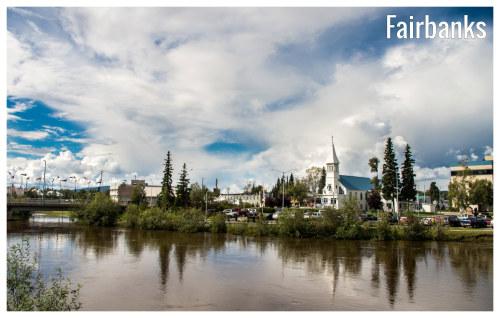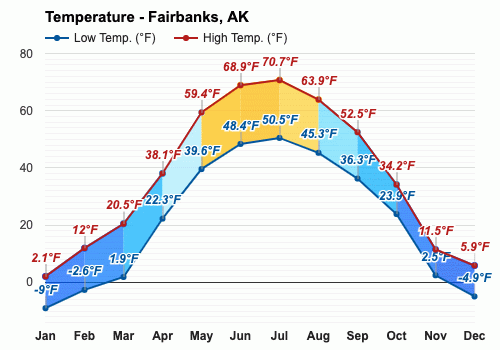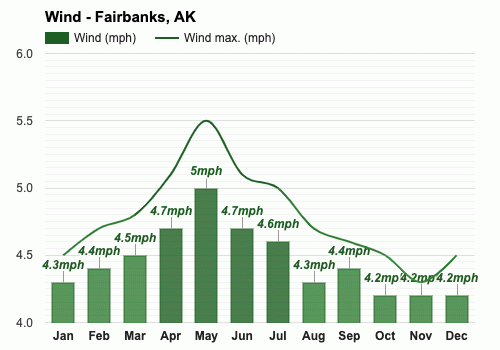Contents
- The climate of Fairbanks
- The Best Time to Visit Fairbanks
- The Worst Time to Visit Fairbanks
- Spring Weather in Fairbanks
- Summer Weather in Fairbanks
- Autumn Weather in Fairbanks
- Winter Weather in Fairbanks
- Weather in January
- Weather in February
- Weather in March
- Weather in April
- Weather in May
- Weather in June
- Weather in July
- Weather in August
- Weather in September
- Weather in October
- Weather in November
- Weather in December
- Frequently asked questions
- Average temperature
- Average pressure
- Average wind speed
- Average humidity
- Average rainfall
- Average rainfall days
- Average snowfall
- Average snowfall days
- Average daylight
- Average sunshine
- Average sunshine days
- Average UV index
- Average cloud cover
- Average visibility

Climate and monthly weather forecast
The climate of Fairbanks
Humidity levels do not show significant fluctuation, remaining generally high throughout the year. The range of humidity, from 57% to 93%, provides a crucial insight into the moisture content of the air. Rainfall further highlights the year-round presence of moisture, with August displaying the highest rainfall of 2.44" (62mm). Interestingly, the number of rainfall days is relatively consistent across the year, suggesting a similar frequency of precipitation events in all seasons.
When it comes to snowfall, a different trend is observed. December and January endure high snowfall conditions in the form of 2.72" (69mm) and 2.09" (53mm) respectively, depicting the severity of winters in the state. The region experiences frequent snowfall days in these two months, further corroborating the typical Arctic weather conditions.
The Best Time to Visit Fairbanks
The Worst Time to Visit Fairbanks
Spring Weather in Fairbanks
Summer Weather in Fairbanks
Autumn Weather in Fairbanks
Winter Weather in Fairbanks
Weather in January
Weather in February
Weather in March
Weather in April
Weather in May
Weather in June
Weather in July
Weather in August
Weather in September
Weather in October
Weather in November
Weather in December
Published by: Weather U.S. | About Us
Data Sources | Weather Forecasting & Climate
Frequently asked questions
What are the coldest months?
What is the driest month?
How much does it rain in Fairbanks?
When does it snow?
How many days does it snow?
When is the lowest UV index?
What is the most humid month in Fairbanks?
When is Daylight Saving Time (DST)?
What is the least humid month?
When it does not snow?
When are the longest days?
What month has the most sunshine?
What is the month with the highest UV index?
What month is the hottest?
What is the wettest month in Fairbanks?
What is the snowiest month?
What is the month with the shortest days?
What is the month with the least sunshine?

Average temperature
Fairbanks, AK
The warmest month (with the highest average high temperature) is July (70.7°F).
The month with the lowest average high temperature is January (2.1°F).
The month with the highest average low temperature is July (50.5°F).
The coldest month (with the lowest average low temperature) is January (-9°F).

Average pressure
Fairbanks, AK
- Average pressure in January:
29.95"Hg - Average pressure in February:
29.97"Hg - Average pressure in March:
29.93"Hg - Average pressure in April:
29.87"Hg - Average pressure in May:
29.89"Hg - Average pressure in June:
29.82"Hg
- Average pressure in July:
29.9"Hg - Average pressure in August:
29.83"Hg - Average pressure in September:
29.77"Hg - Average pressure in October:
29.79"Hg - Average pressure in November:
29.85"Hg - Average pressure in December:
29.86"Hg
The month with the highest atmospheric pressure is February (29.97"Hg).
The month with the lowest atmospheric pressure is September (29.77"Hg).

Average wind speed
Fairbanks, AK
- Average wind speed in January:
4.3mph - Average wind speed in February:
4.4mph - Average wind speed in March:
4.5mph - Average wind speed in April:
4.7mph - Average wind speed in May:
5mph - Average wind speed in June:
4.7mph
- Average wind speed in July:
4.6mph - Average wind speed in August:
4.3mph - Average wind speed in September:
4.4mph - Average wind speed in October:
4.2mph - Average wind speed in November:
4.2mph - Average wind speed in December:
4.2mph
The windiest month (with the highest average wind speed) is May (5mph).
The calmest months (with the lowest average wind speed) are October, November and December (4.2mph).

Average humidity
Fairbanks, AK
The month with the highest relative humidity is March (93%).
The month with the lowest relative humidity is June (56%).

Average rainfall
Fairbanks, AK
- Average rainfall in January:
0.31" - Average rainfall in February:
0.43" - Average rainfall in March:
0.55" - Average rainfall in April:
0.83" - Average rainfall in May:
0.55" - Average rainfall in June:
1.22"
- Average rainfall in July:
1.34" - Average rainfall in August:
2.44" - Average rainfall in September:
1.26" - Average rainfall in October:
0.71" - Average rainfall in November:
0.83" - Average rainfall in December:
0.39"
The wettest month (with the highest rainfall) is August (2.44").
The driest month (with the least rainfall) is January (0.31").

Average rainfall days
Fairbanks, AK
- Average rainfall days in January:
3 days - Average rainfall days in February:
1.8 days - Average rainfall days in March:
4.2 days - Average rainfall days in April:
11.3 days - Average rainfall days in May:
10.8 days - Average rainfall days in June:
12.4 days
- Average rainfall days in July:
12.9 days - Average rainfall days in August:
16.4 days - Average rainfall days in September:
13.1 days - Average rainfall days in October:
7.7 days - Average rainfall days in November:
3.7 days - Average rainfall days in December:
3.2 days
The month with the highest number of rainy days is August (16.4 days).
The month with the least rainy days is February (1.8 days).

Average snowfall
Fairbanks, AK
- Average snowfall in January:
2.09" - Average snowfall in February:
3.31" - Average snowfall in March:
3.82" - Average snowfall in April:
2.95" - Average snowfall in May:
0.43" - Average snowfall in June:
0"
The month with the highest snowfall is November (6.5").
The months with the least snowfall are June and July (0").

Average snowfall days
Fairbanks, AK
- Average snowfall days in January:
9.4 days - Average snowfall days in February:
9.7 days - Average snowfall days in March:
11.7 days - Average snowfall days in April:
8.9 days - Average snowfall days in May:
1.7 days - Average snowfall days in June:
0 days
- Average snowfall days in July:
0 days - Average snowfall days in August:
0.1 days - Average snowfall days in September:
1.6 days - Average snowfall days in October:
6.5 days - Average snowfall days in November:
13.3 days - Average snowfall days in December:
11.4 days
The month with the highest number of snowfall days is November (13.3 days).
The months with the least snowfall days are June and July (0 days).

Average daylight / Average sunshine
Fairbanks, AK
- Average daylight in January:
5h and 2min - Average daylight in February:
8h and 3min - Average daylight in March:
11h and 5min - Average daylight in April:
15h and 2min - Average daylight in May:
18h and 5min - Average daylight in June:
21h and 3min
- Average daylight in July:
19h and 5min - Average daylight in August:
16h and 2min - Average daylight in September:
13h and 0min - Average daylight in October:
9h and 4min - Average daylight in November:
6h and 1min - Average daylight in December:
4h and 0min
The month with the longest days is June (Average daylight: 21h and 30min).
The month with the shortest days is December (Average daylight: 4h and 0min).
- Average sunshine in January:
3h and 2min - Average sunshine in February:
4h and 1min - Average sunshine in March:
5h and 4min - Average sunshine in April:
7h and 2min - Average sunshine in May:
11h and 4min - Average sunshine in June:
12h and 1min
- Average sunshine in July:
11h and 4min - Average sunshine in August:
9h and 3min - Average sunshine in September:
7h and 2min - Average sunshine in October:
5h and 4min - Average sunshine in November:
3h and 4min - Average sunshine in December:
2h and 0min
The month with the most sunshine is June (Average sunshine: 12h and 6min).
The month with the least sunshine is December (Average sunshine: 2h and 0min).

Average sunshine days
Fairbanks, AK
- Average sunshine days in January:
21.4 days - Average sunshine days in February:
18.7 days - Average sunshine days in March:
19.5 days - Average sunshine days in April:
12.2 days - Average sunshine days in May:
16.5 days - Average sunshine days in June:
14.8 days
- Average sunshine days in July:
15.8 days - Average sunshine days in August:
12.8 days - Average sunshine days in September:
14.1 days - Average sunshine days in October:
18.9 days - Average sunshine days in November:
18 days - Average sunshine days in December:
19.7 days
The month with the most sunshine days is January (21.4 days).
The month with the least sunshine days is April (12.2 days).

Average UV index
Fairbanks, AK
The months with the highest UV index are June and July (UV index 5).
The months with the lowest UV index are January, February, March, November and December (UV index 1).

Average cloud cover
Fairbanks, AK
The months with the most cloud cover are March, April and November (Cloud cover 53).
The month with the least cloud cover is May (Cloud cover 39).

Average visibility
Fairbanks, AK
The months with the highest visibility are May, June, July, August, September and October (6mi).
The months with the lowest visibility are January, February, March, April, November and December (4mi).